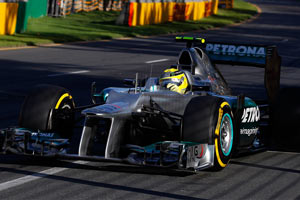I think the main brake proportioning is still done with some kind of mechanical linkage at the pedal and master cylinder area. The proportioning valve in the picture is a relatively off-the-shelf unit that is used precisely because it has some hysteresis. The teams cleverly use this to create a brake-bias transient during braking.hardingfv32 wrote:Well, if that is what they currently us it is not very sophisticated. That is a two position valve that actually only reduce the pressure to one end of the brake system. It would be simple to use, but IF that is all they have for a brake balance adjustment then the driver has no way to make the tradition front to rear brake adjustment that you get from manipulating the brake balance bar.Patriiick wrote:It s the brake balance lever.
here is a pic of what it looks like found on the forum (courtesy scarbs f1)
http://scarbsf1.files.wordpress.com/201 ... 030498.jpg
Brian
At initial brake application the car can slow at several G's due to high speed and downforce. This creates large longitudinal weight transfer and a need for more front brake bias. Later in the brake application (a brief second or two in F1) the car is much slower and has less downforce and less decel G's. This means less longitudinal weight transfer and therefore a need for relatively less front bias. This creates a need for a change in front-rear brake balance during the braking event (transition from more front bias to less front bias). It could be done with electronics but that's banned by rules. So the pressure-reducing valve is used because it has some hysteresis that can match the desired balance change during short events.
I learned this from F1T and a couple magazines. If I remember correctly, this was one of the things that McLaren learned from the Ferrari during spy-gate several years ago. As a result McLaren was banned from using this system the following season while the rest of the grid was allowed to. Not arguing, just giving some perspective.




